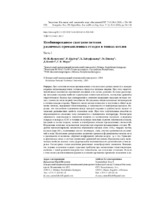Комбинированное сжигание потоков различных промышленных отходов в топках котлов

Date
2020Publisher
Another Title
Combined Combustion of Various Industrial Waste Flows in Boiler Furnaces
Bibliographic entry
Ярмольчик, Ю. П. Комбинированное сжигание потоков различных промышленных отходов в топках котлов = Combined Combustion of Various Industrial Waste Flows in Boiler Furnaces / Ю. П. Ярмольчик [и др.] // Энергетика. Известия высших учебных заведений и энергетических объединений СНГ. – 2020. – № 6. – С. 526-540.
Abstract
При сжигании потоков промышленных отходов (смеси разных веществ) в камерах сгорания теплогенерирующих установок образуется тепловая энергия. При этом энергетический вклад химических соединений, входящих в их состав, различен. В статье рассмотрены энтальпии сгорания наиболее характерных химических веществ, составлены уравнения энергетического баланса при одновременном сжигании нескольких массовых потоков топлив с учетом их теплотворной способности. Исследованы общие механизмы теплопередачи к стенкам камеры сгорания. Приведен анализ вклада конвекции и излучения в общее количество теплоты, переданной теплогенератору, в зависимости от температуры процесса. Показано, что теплообмен излучением между камерой сгорания и трубами котла зависит от тепловых радиационных свойств отложения золы. При этом излучательная способность образовавшегося отложения золы уменьшается с повышением температуры. Рассмотрена зависимость максимального излучения пламени от соотношения массового содержания углерода и водорода (С/Н) в топливе на примере исходных горючих химических веществ, входящих в состав твердых, жидких и газообразных отходов промышленных технологий. Определены основные загрязняющие вещества при сгорании промышленных отходов. Подробно проанализированы механизмы образования оксидов азота (NOx), твердых частиц, оксидов серы (SОx), галогеновых кислот, полимеров, сажи, летучих органических соединений и золы. Исследовано распределение различных процессов формирования оксидов азота в зависимости от величины, обратной коэффициенту избытка воздуха (φ = 1/α). Приводится физическая схема и система химических уравнений механизма образования сажи, включающая наиболее важные этапы формирования полициклических ароматических углеводородов. Рассмотрены стадии выделения реактивных золообразующих элементов. Показано, что зольные отложения создают серьезные проблемы при эксплуатации теплогенераторов, особенно с такой развитой поверхностью теплообмена, как котельные установки. В связи с этим также уделено внимание формам и условиям протекания процессов осаждения золы.
Abstract in another language
When industrial waste flows (mixtures of different substances) are burned, thermal energy is generated in the combustion chambers of the heat generating plants. In this case, the energy contribution of the chemical compounds included in their composition is different. The article considers the enthalpies of combustion of the most characteristic chemicals, formulates the energy balance equations while simultaneously burning several mass flows of fuels, taking into account their calorific value. The general mechanisms of heat transfer to the walls of the combustion chamber are investigated. An analysis is made of the contribution of convection and the radiation mechanism to the total amount of heat transferred to the heat generator, depending on the process temperature. It is demonstrated that the heat transfer by radiation between the combustion chamber and the boiler tubes depends on the thermal radiation properties of ash deposition. In this case, the emissivity of the resulting ash deposition decreases with increasing temperature. The dependence of the maximum flame radiation on the C/H ratio by weight is considered using the example of the initial combustible chemicals that are part of solid, liquid and gaseous wastes of industrial technologies. The main pollutants which emerge during the combustion of industrial waste are determined. The mechanisms of formation of nitrogen oxides (NOx), particulate matter, sulfur oxides (SOx), halogen acids, polymers, soot, volatile organic compounds and ash are considered in detail. The distribution of various processes of formation of nitrogen oxides depending on the value inverse to the coefficient of excess air (φ = 1/α) is determined. A physical scheme and a system of chemical equations of the mechanism of soot formation which includes the most important stages of the formation of polycyclic aromatic hydrocarbons are presented. The stages of the separation of reactive ash-forming elements are considered. It is demonstrated that ash deposits pose serious problems in the operation of heat generators, especially those that have such a developed heat exchange surface, such as boiler plants. In this regard, the forms and conditions of the processes of ash deposition are also considered separately. The combustion conditions affecting the state, size and distribution of solid particles and the condensed phase of ash are determined.
View/
Collections
- № 6[7]
